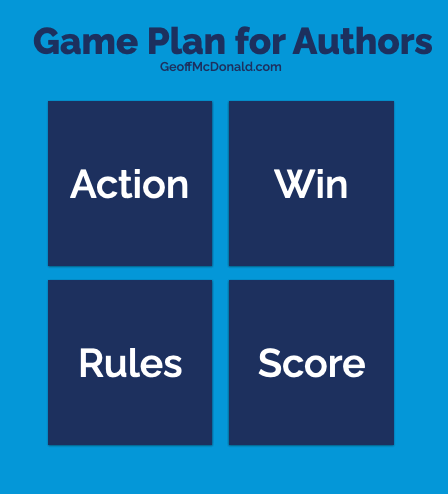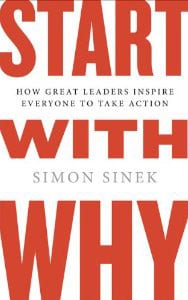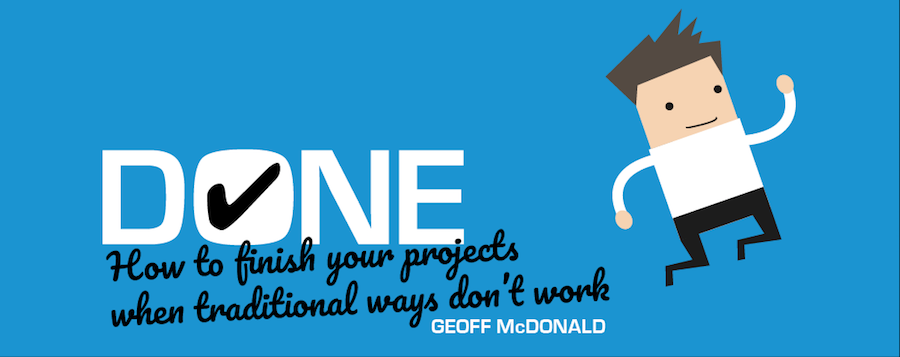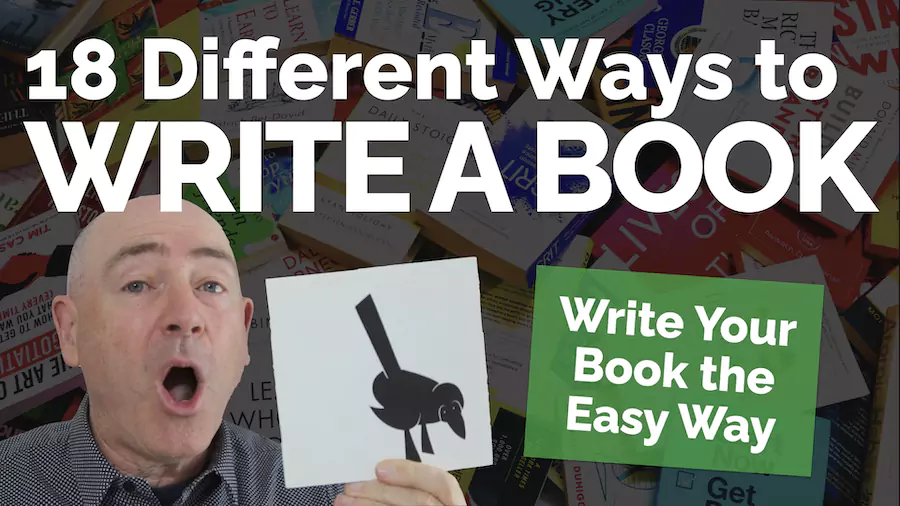If you were sitting down in front of me and asked, ‘What are the best tips for writing a book for the first time, how would you answer?’
That’s a great question. I’ve written and self-published 10 books and each time I start a new book I’m giddy with excitement. But what are writing tips that will make the biggest difference to helping you write, publish and sell your book?
In this post, I’ll share the best 10 tips for writing a book for first-time and repeat authors – regardless of the type of book you’re writing. It’s ideal for budding authors, content creators and thought leaders.
1 You Must have a Game Plan

They create a Game Plan. In other words, they sit down and think about how they’re going to win.
To win with your book, you need a game plan too. I believe this is so important, I’ve written an entire book about it called the Done Game Plan. It’s a project plan for achieving great things.
There are four key questions you need to answer:
- How do you win?
- How are you going to keep score?
- What are the rules of the game?
- What actions do you need to take to win?
I’m currently creating a new version of this book, especially for authors. Look out for this in future posts.
2 Remind Yourself Why

But it’s only 10% of the story. The other 90% is Keep Going with Why. It’s not just Start With Why – it’s Keep Going with Why.
One thing you must do before you start writing your book, is write down your why – why are you writing this book? Then you want to keep it handy for when you want to quit, are struggling with motivation or want to start something else.
For example, my WHY for The Ideas Architect Bible is: “I’m writing this book to record my legacy. It’s a record of the ideas and concepts that I’ve developed in helping clients design, build and lead with their ideas.”
Knowing your why is not what makes the difference. It’s consistently reminding yourself of it.
At some point, we all fall off our metaphorical horse (be it writing a book, running a marathon or sticking with a relationship). Knowing your why is the reason to get back on your horse – even when you might be feeling sick, sore or sorry for yourself. This one tip could make the difference between you finishing your book, or not.
3 Don’t waste time on a title
One of the biggest time wasters I’ve seen for first-time authors make is they sit around for days and weeks trying to come up with the world’s best book title before they start writing any words. That’s called procrastination.
Instead, create a working title and then start writing. And give yourself permission to change it later. Let the final title emerge as you write.
The simple reason for this is that as you write your book your understanding of what you’re writing about will change.
Typically for me, great headlines and titles come from talking with people. Either I say something accidentally or the person I’m speaking with does. Then we look at each other – That’s it! That’s the title.
Just start writing and listen for your title as it emerges. Simply listen to how you refer to your book and what keywords the people you speak with say.
Book Title Example: Done
As I mention below, this book was originally going to be consistent with the program I was running at the time, Project Done. (Even that program started out under a different name, Project Passion). Naturally, the book was going to be called, ‘Project Done’. Later, I shortened it, ‘Done’.
Book Title Example: The Ideas Architect Bible
For instance, I’m currently writing a new book loosely titled, The Ideas Architect Bible. I’ve called myself the ‘Ideas Architect’ for a long time because I used to be an architect, but instead of buildings I now design ideas. That was a given. The Bible reference is not to my religion. Instead, I wanted to write the definitive book on the topic of ideas architecture – how to design ideas. But further, it’s not really THE bible, more so, it’s MY bible. I want it to be the ultimate collection of what I know about this topic.
At the moment, I love the title. It works for me. But I haven’t really tested it with my potential audience. It might stick. And I might stick with it regardless of what my audience says. Either way, it captures the spirit of my book enough to inspire me to write it.
In my case, I have a strong working title almost from day one. Be patient, your final title might not emerge until you come to design the cover for your book. Just be ready to catch it when it does show up.
4 Make it Real
One of the biggest challenges for any creative project is that you don’t really know what it’s going to be like when you’re done.
On day one of writing your book, you’re probably sitting there with a vague idea about what your book will look like. This can be uncomfortable, and it can put a dent in your motivation. What am I really creating here?
To make your book real, create a mock-up of your final book. In other words, create a visual representation of your finished book.
For a print book, that means the size, shape and look and feel of your finished book. It really helps if you can have a physical book in your hands to say, ‘I want my book to be like this.’ You might need several examples to fulfil this task. One example might be the right size and weight while another might be the interior design of your book.
The Ideas Architect Bible Mock-Up
For my current book, The Ideas Architect Bible, I’ve been fortunate in that I can grab my previous book, Weekly Done and use this as my mock-up. But you might have to go to the library or a bookstore to find the print book you’re looking for.
You can see in the video (above) that I literally created this in minutes. It’s rough but it’s ready. It’s good enough for right now. The idea or analogy is that ideas shine the light or illuminate our understanding in new ways. And the cover shows a light or a torch with the title of the book in the spotlight.
If you’re writing a digital book, it’s much easier – all you need to do is create a mock-up of the cover. Then you can paste it on your wall or put it in a picture frame as a daily reminder. This can be hand drawn or quickly mocked up in Keynote or on Canvas. It’s not meant to be a finished piece of design.
A really quick and easy way to do this is to go to a site like Unsplash or Pexels (two of my go-to places for free pics and videos) which have a lot of free photos. Find one that captures the essence or feel of your book and then type or write your title over the top. You can print this out and use this as your physical mock-up. You can also add it as the screen saver of your devices for further inspiration.
Don’t try to get this right. Just create your first mock-up and get started. You can change this as you write your book.
5 Know Your Finish Line
On the surface this might sound like a dumb question, when is your book finished? And I don’t mean a specific date. I do mean, in your head, when are you going to be finished with your book project?
Here are some examples to consider:
- Words – Is it finished when the words are written? This might be when you hand your manuscript to a publisher or editor.
- Design – Is it finished when the book is designed? This might be true if it’s a digital book.
- Hand – Is your book finished when your shiny new book is in your hand? This is a really satisfying moment for all print authors. But is it the finish of your project?
- Launch – Is your book finished when you have the launch with your family, friends, clients and colleagues all there?
- Sales Milestone – Or do you have to sell 1000 copies – or some other made-up number to pass the author test
- Next Book – Alternatively, have you finished your book when you’ve started your next book?
- Never – Or is being an author like being a parent? Even though they’re an adult with their own children, will you always be wanting to share, sell and promote your little baby?
When will your book be finished?
Knowing when your book is finished and done is important so you can stop and celebrate your achievement. You don’t want to stop too soon or too late.
In the past, I’ve made the mistake of thinking that my book writing projects were finished when I’ve finished writing them or had a digital design on my computer. In hindsight, I needed to adjust the finish line to sharing and selling it to ensure I gained the best return on my effort of creating it.
6 Write the Right Book
Of all the books I’ve written, my favourite book is Weekly Done. It was a joy to write. Plus, I had always wanted to print a hardcover book so the look and feel were exactly what I was looking for.
Further, I’ve had quite a few colleagues say to me, ‘That book is so you, Geoff’. In other words, it’s a signature style. And that’s exactly how it felt when I had my first hot copy in my cold little hands. It’s no surprise that I wrote two volumes of Weekly Done and my current book, The Ideas Architect Bible, will be in the same format.
It was most definitely the right book for me to write.
In a previous post, I shared 18 different ways to write a book. But which one is the right one for you?
To some extent you’re not really going to know unless you put them to the test. And that’s especially true for first-time book authors. But I also think you can have a good guess as to which one sounds right or feels right for you.
I suggest you look at that blog post to help you choose the book format that appeals to you. It will make writing your book much easier and you’ll produce a better book as a result.
7 Don’t expect a Straight Line
When I came to write my book, Done, I thought it was going to be a simple and straightforward process.
I was already running a group coaching program called Project Done and my intention was simply to translate the course to a book. But it didn’t turn out that way. After a few false starts, I had to come up with a completely different plan for my book. I finished up creating a manifesto – The Seven Rules of Done – and wrote my book based on that.
You will need to start out with a plan of how you think it will all work. But as former heavyweight boxing champ, Mike Tyson once said, ‘Everyone has a plan until they get punched in the mouth.’
If you’re lucky your book writing may almost be a straight line from start to finish, but it’s more likely that it won’t. Instead, like a good thriller, it will have a few exciting twists and turns along the way.
8 Write your book in public
In an earlier post, the Best and Worst Times to Make Money From Content, I shared the story of Seth Godin and his book Unleashing the Ideas Virus.
Spoiler Alert – In that example, Seth wrote the entire book and then gave the entire book away for free. He did this to build a bigger audience for his book.
Since then, Seth has written 20 best-selling books. And he has done this by publishing a blog post every single day for over 7000 days. That’s almost 20 years of daily blogging.
In writing his daily blog post, Seth wrote his books in public and built a bigger audience at the same time. I suggest you do the same. It’s a great way to build your audience, gain feedback to write a better book and sell more copies. Publish your book as your write on your blog, on LinkedIn or where ever you hang out.
9 Only listen to authors
A long time ago I went to a Robert Kiyosaki event where he was talking about investment advice. He told the story of a guy he met who insisted he would never invest in the stock market. When asked why, the man replied, ‘because my neighbour once had a bad experience and he told me not to.’
Everyone will have their opinion about your book. But if someone is telling you how to write a book, and they haven’t done that themselves, then don’t listen. And even if they are an author, check their advice to see if it is worth following.
10 Do what Jerry Seinfeld Did
In the previous post, I shared some of the mistakes that I have made in writing my ten books. While writing ten books is an achievement I’m very proud of, I also believe that could easily have been 20 or 30 books had I done one thing.
That one thing was to build a daily writing habit.
The easiest way I’ve found to write a book is to write every day and it’s what Jerry Seinfeld did in writing comedy. He wrote every day and marked this on a wall calendar. Famously, he said the secret to his success was ‘Don’t Break the Chain’.
Do what Jerry Seinfeld did – build your writing habit every day to finish your book faster and easier.
More tips on Writing Your First Book
If you want more help writing your book, here are three related blog posts to read:
- The best reasons to write a book right now
- Book Writing Template – Make Your Book Great in 6 Steps
- Ten Book Writing Mistakes I’ve Made [Author Mistakes]
And if you want some coaching to help you write a better book faster, then contact me here.
Add a comment below: Which one of these books writing tips most appealed to you? Pick the ones that appeal to you and put them into action today.







